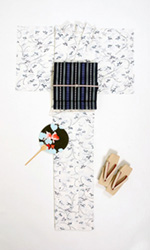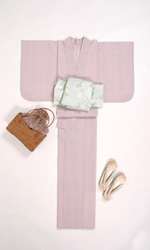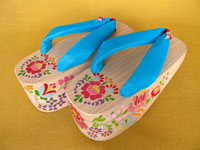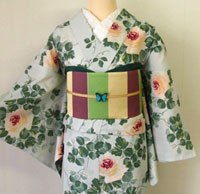Web Japan > Trends in Japan > Fashion&Design > Yukata
Yukata
Traditional Garment for Summer

Candidates for "Miss Yukata" 2012 in colorful yukata at Kinosaki Onsen, Hyogo Prefecture. ©Kinosaki Hot Spring Tourist Association
Yukata is a traditional Japanese summer garment that makes women look particularly beautiful. It is a type of traditional kimono, but more casual than conventional kimono. Yukata is popular among young women for dressing up to go out to special summer events such as firework displays or bon-odori dance festivals. In recent years, yukata with modern, colorful, bold patterns has appeared, and many women enjoy coordinating yukata with obi (sash) and geta (wooden clogs), etc.
Comfortable Wear in Summer
Yukata is usually made of cotton fabric, which lets air through. And whereas an ordinary set of kimono requires juban, or kimono underwear, yukata can be worn without juban and tabi (Japanese socks) as well, which makes it a very comfortable garment for summer. Yukata dates back more than 1,000 years, when noble persons wore it to and from taking a bath. The custom of wearing yukata spread to ordinary people in the 17th to 19th centuries, and has been handed down to us. There also is yukata for men, but today it is mostly women who choose to wear it.
Traditional yukata usually has patterns of flowers or grasses against a white or indigo blue background. White yukata used to be worn indoors during the day to appear crisp and cool, while indigo blue yukata was worn for going out in the evenings because the scent of indigo, used to dye the fabric, repelled insects. Yukata is something the Japanese have invested a great deal of ingenuity in developing it as an ideal summer garment.

If you put on yukata right, it naturally makes your comportment befitting a Japanese woman. ©Kinosaki Hot Spring Tourist Association
Enlarge photoBut in addition to its comfort, yukata is loved in Japan as a garment which draws out the charm of a woman to the greatest extent. Like kimono, yukata comes loose at the top or at the bottom if the wearer gestures extravagantly or walks with long strides. In order to appear elegant in yukata, you must pull yourself up straight, walk in small steps and refrain from making large gestures. Therefore, wearing yukata always makes you behave in a refined manner.
Colorful Designs of Yukata
In addition to traditional patterns, new types of yukata with colorful designs have appeared in recent years. Nowadays there are contrasting color patterns: yukata which is mostly black or red, and yukata that uses bold, primary colors such as blue or pink in the pattern. Patterns are often traditional motifs of flowers or grasses, but with bold, vivid mixtures of colors to emphasize the contrast between the shade of the fabric and color of the pattern. Novel geometric designs are also increasingly used for the pattern.
One of the pleasures of wearing yukata is choosing the obi (sash) to go with it. If yukata is a cold color, you can choose an obi of warm color to make it stand out, or an obi in the same color family to be chic. Young women also like to experiment with obi. On top of the traditional obi, some women now wear another obi of light, transparent material – and arrange the two obi as flowers or wings in the back.
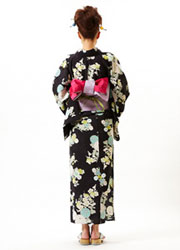
|

|
|
Left: A butterfly-like arrangement of obi, popular among young women. Right: Putting another transparent obi on top of the solid cloth obi makes a cute, modern look. ©Furifu |
|
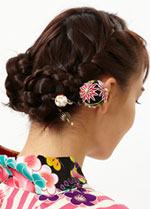
|
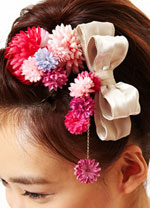
|
| Left: Kanzashi, a traditional Japanese hair ornament, used in a hairstyle done up to look gorgeous. ©Furifu Right: Hair ornament consisting of large and small flowers and a bow. ©Furifu | |
Yukata is worn with geta, or traditional Japanese wooden clogs, as it is important to dress your feet elegantly as well. Geta look like beach sandals with hanao (thongs) to slide the feet into. There are women and girls who stick accessories on hanao as accents, or wear pokkuri (geta with thick, rounded soles, originally worn by children) to show their individuality or to appear kawaii (cute).
The beauty of yukata is that you can wear it in many ways and enjoy your ideas. You can put an obidome (an ornament worn at the front of an obi) which looks like a Western brooch, or arrange your hair elaborately and pin big flowers or a kanzashi (hair ornament) to it as a final flourish.
Make Your Own Yukata

A yuzen atelier in Kyoto welcomes an increasing number of people who come to create their own yukata using an authentic dyeing process. © Marumasu-Nishimuraya Co., Ltd.
Enlarge photoEvery summer, young women throng to yukata corners of department stores or specialty shops to buy a new yukata to wear that season. Some women begin to shop in May for fabric to be made into a yukata. Such women are on the increase.
If you want to dye your own yukata, you can do so by learning how to dye a yukata. One of such classes is the yuzen process of paste-resist dyeing from artisans at Kyo-yuzen ateliers in Kyoto. After you dye your own fabric, they will tailor-make it into a yukata for you. It takes three days and many processes to dye each pattern color separately and to dye the background color. It really feels special to wear your own beautifully made kimono.
Yukata is traditional Japanese summer wear, forming an unbroken tradition among women while incorporating new designs. The sight of women casually, but elegantly, dressed up in yukata is a custom which adds much color to the summer in Japan.
(August 2012)
- Trends in Furisode (February 2011)

